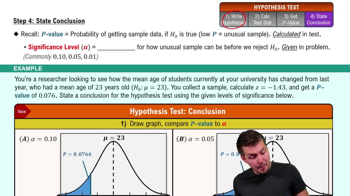n Exercises 1–6, the statement represents a claim. Write its complement and state which is H0 and which is Ha.
μ = 82
 Verified step by step guidance
Verified step by step guidance Verified video answer for a similar problem:
Verified video answer for a similar problem:



 5:12m
5:12mMaster Intro to Hypothesis Testing with a bite sized video explanation from Patrick
Start learning